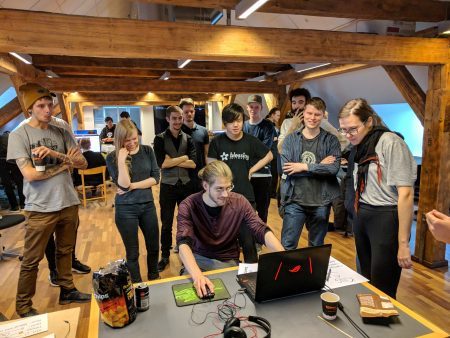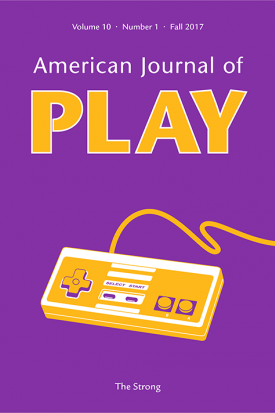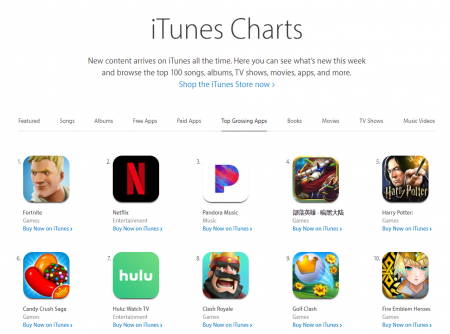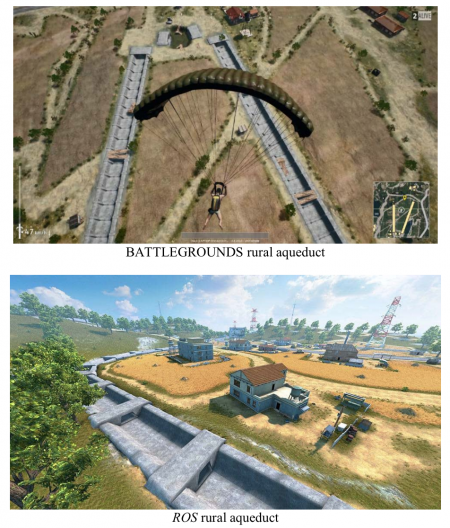Jesper Juul's Blog, page 10
May 24, 2018
American Journal of Play Vol 10 no 2
For your theoretical consumption, American Journal of play Vol 10 no 2.
Editor’s Note
Editor’s Note
Articles
Theme and Variation: Arranging Play’s Forms, Functions, and “Colors”
Thomas S. Henricks
Abstract Only> Full Text>
*
Examining Literacy Practices in the Game Magic: The Gathering
Autumn M. Dodge (with Paul A. Crutcher)
Abstract Only> Full Text>
*
Toward Creativity : Do Theatrical Experiences Improve Pretend Play and Cooperation among Preschoolers?
Meredith L. Rowe, Virginia C. Salo, and Kenneth Rubin
Abstract Only> Full Text>
*
Role Playing in Children’s Literature: Zilpha Keatley Snyder and The Egypt Game
Cathlena Martin
Abstract Only> Full Text>
Book Reviews
Michael M. Patte and John A. Sutterby, eds., Celebrating 40 Years of Play Research: Connecting Our Past, Present, and Future, Vol 13, Play & Culture Studies
Miguel Sicart
First Paragraph Only> Full Text>
*
Tristan Donovan, It’s All a Game: The History of Board Games from Monopoly to Settlers of Catan
Susan Asbury
First Paragraph Only> Full Text>
*
Cathy A. Malchiodi and David A. Crenshaw, eds., What to Do When Children Clam Up in Psychotherapy: Interventions to Facilitate Communication
John W. Seymour
First Paragraph Only> Full Text>
*
Linda A. Reddy, Tara M. Files-Hall, and Charles E. Schaefer, eds. , Empirically Based Play Interventions for Children
Gabriel I. Lomas
First Paragraph Only> Full Text>
*
Brian C. Baer , How He-Man Mastered the Universe: Toy to Television to the Big Screen
J. Richard Stevens
First Paragraph Only> Full Text>
*
Melanie Swalwell, Helen Stuckey, and Angela Ndalianis, eds., Fans and Videogames: Histories, Fandom, Archives
Samuel Tobin
First Paragraph Only> Full Text>
*
Stephanie Boluk and Patrick Lemieux, Metagaming: Playing, Competing, Spectating, Cheating, Trading, Making, and Breaking Videogames
Riccardo Fassone
First Paragraph Only> Full Text>
*
Robertson Allen, America’s Digital Army: Games at Work and War
Jay Mechling
First Paragraph Only> Full Text>*
Soraya Murray, On Video Games: The Visual Politics of Race, Gender, and Space
Michael Anthony DeAnda
First Paragraph Only> Full Text>
May 4, 2018
Will “core” Games dominate Mobile?
We’ve had a long period where mobile platforms (were seen as) dominated by casual games (games flexible towards different use cases, and mostly positive in their fictions), but with the release of Fortnite on iOS, we suddenly have a situation where a more traditional shooter is top grossing.
In an MCV interview, Tim Sweeney argues that this is the future: that “serious” games (sic) will be dominant the mobile charts.
Well. It’s true that Fortnite is new in this context in terms of being a top-grossing shooter. But the news is not so much that it is a “serious” game, meaning one that has depth and that players can keep improving their skills at. Candy Crush is an involved game if you try to get far, and so is Clash Royale, and the latter one is about multiplayer competition as well.
The news is really that a traditional “core” game genre, in this case the shooter, has been successfully launched on mobile platforms.
April 6, 2018
How to sue a cloner
The question of cloning usually leads to great agitation, and I’ve written about the technical issues of what is legal before.
I think I am in the minority for believing that weak copyright protections are preferable to strong ones, but I do believe that strong copyright protections would eventually lead to all game genres effectively being owned by large companies with many lawyers.
So, PLAYERUNKNOWN’S BATTLEGROUNDS: When Fortnite Battle Royale came out (the more successful game as of now), it was widely seen as copying PUBG’s battle royale format – except
a) this wasn’t invented by PUBG
b) a game format like battle royale is not the kind of thing you can copyright (it’s an idea), but you have copyright over the expression of that idea, so legal action has to happen on the grounds that the offending party made too many similar design decisions that were not necessary.
Now Ars Technica reports that PUBG corp is suing Chinese developer Netease. Their legal argument is illustrative of how such lawsuits can be made: the general game structure of PUBG cannot be legally defended, but a developer that makes too many similar choices in game design, level design, and visual design will be legally vulnerable:
The suit individually describes characteristics of the game as “a copyrightable audio-visual work, individually and/or in combination with other elements of Battlegrounds,” and it includes screenshots of the competing game to make a case of infringement. Remarkably, PUBG Corp lists what it believes are 25 copyrightable characteristics about the game…
PUBG Corp’s argument appears to hinge on that “in combination with other elements” label, as both targeted games include examples of each of the 25 elements by way of screenshot or gameplay description. As the lawsuit contends, “The use of cookware as a weapon or armor in a shooter game, the use of certain vehicles and landscapes and combinations thereof, the use of distinctive supply boxes, and the celebratory reference to chicken are elements of ornamental flair that are not functional but have acquired secondary meaning, as shown by their use by players in memes, parodies, skits and other contexts to refer to the Battlegrounds game and to its developer, i.e., PUBG.”
March 13, 2018
The Impossibility of the Internet of Things
XKCD is right: The Internet of Things is not going to work, as long as there is no guarantee of security updates, which there won’t be.
(I will start posting more.)
February 14, 2018
Appy to the Visual Game and Media Design Master’s program in Copenhagen, deadline March 1st
This is for the program that I run in Copenhagen. Join us!
Apply to the Visual Game and Media Design Master’s program at KADK in Copenhagen. The Application deadline for the 2018-2020 class is March 1st.

The application process is now open for the Visual Game And Media Design master’s program at KADK – the Royal Danish Academy of Fine Arts, School of Design in Copenhagen.
This is a two-year program running from September 1, 2018. The application deadline is March 1st.
Visual Game and Media Design is an intensive two-year program for students wishing to do creative work in game design, visual media, and beyond. During the program, you will continually combine the hands-on creation of digital games, animations, motion graphics and visual designs with innovative conceptual approaches to game design and storyworld design.
Who can apply? The master’s program in Visual Game and Media Design is in English, and is open to all students, Danish and International, with a relevant bachelor’s degree in fields such as graphic design, game design, animation, or 3D modeling. We encourage students with nontraditional backgrounds to apply.
The master’s program in Visual Game and Media Design is in English, and is open to all students, Danish and International, with a relevant bachelor’s degree in fields such as graphic design, game design, animation, or 3D modeling. We encourage students with nontraditional backgrounds to apply.
More about the program and application process
To learn more about the program, and to apply, go to the website or email program head Jesper Juul, jjuul@kadk.dk
https://kadk.dk/en/programme/visual-game-and-media-design
Why study at KADK in Copenhagen?
KADK is a leading academy in Scandinavia in the fields of architecture, design and conservation. It is located centrally by the Copenhagen harbor.
Copenhagen is a hub for video game development, with a vibrant English-language game development community, and home to both small and large companies such as Sybo games, IO Interactive, Playdead and Unity3D.
KADK works closely with (and is situated next to) the National Film School of Denmark, and with the professional TV and Film community in Denmark.
January 26, 2018
American Journal of Play 10.1
 For your intellectual stimulation, American Journal of Play Volume 10, Number 1.
For your intellectual stimulation, American Journal of Play Volume 10, Number 1.
Editor’s Note
The New Video Game History
Interview
Collecting, Preserving, and Interpreting the History of Electronic Games: An Interview with Jon-Paul C. Dyson
Overview Only> Full Text>
Articles
New…Now?: Or Why a Design History of Coin-op Video Game Machines
Raiford Guins
Abstract Only> Full Text>
Ronnie, Millie, Lila—Women’s History for Games: A Manifesto and a Way Forward
Carly Kocurek
Abstract Only> Full Text>
Let’s Begin Again: Sierra On-Line and the Origins of the Graphical Adventure Game
Laine Nooney
Abstract Only> Full Text>
Teaching Us to Fear: The Violent Video Game Moral Panic and the Politics of Game Research
Patrick M. Markey and Christopher J. Ferguson
Abstract Only> Full Text>
Book Reviews
Ian Bogost, Play Anything: The Pleasure of Limits, the Uses of Boredom, and the Secret of Games
James D. Ivory
First Paragraph Only> Full Text>
Jason Reid, Get Out of My Room!: A History of Teen Bedrooms in America
Jamie C. Saucier
First Paragraph Only> Full Text>
Eric J. Green, Jennifer N. Baggerly, and Amie C. Myrick, Counseling Families: Play-Based Treatment
Carol Korn-Bursztyn
First Paragraph Only> Full Text>
Tanya Jones, ed., Toy Stories: The Toy as Hero in Literature, Comics, and Film
Michelle Parnett-Dwyer
First Paragraph Only> Full Text>
Michael Z. Newman, Atari Age: The Emergence of Video Games in America
Anastasia Salter
First Paragraph Only> Full Text>
Dan Ackerman, The Tetris Effect: The Game That Hypnotized the World and Tetris: The Games People Play
Jennifer deWinter
First Paragraph Only> Full Text>
Phillip Penix-Tadsen, Cultural Code: Video Games and Latin America
Tom Apperley
First Paragraph Only> Full Text>
Contributors
Patrick M. Markey and Christopher J. Ferguson
December 18, 2017
Open call for PhD projects at KADK in Copenhagen
At KADK in Copenhagen, we are posting a call for PhD applications for 2018, with deadline January 12, 2018.
This is an open call which can include, of course, games. A game PhD would be located with the research group of Visual Media. We are interested in candidates with strong research interests of their own.
KADK is a lively multidisciplinary institution located centrally in Copenhagen, offering a BA and MA in game design.
Please contact me for any questions. Jesper Juul. jjuul@kadk.dk
Open call for PhD applications at The Royal Danish Academy of Fine Arts Schools of Architecture, Design and Conservation (KADK)
The Royal Danish Academy of Fine Arts Schools of Architecture, Design and Conservation (KADK) invites applications within subject areas of the institution for prequalification in connection with The Danish Council for Independent Research (DFF) Call for Research Educations outside the Universities (PhD).
PhD positions are 3 years, and fully funded and salaried.
Application
Applications to KADK must contain the following documents in PDF format:
Project description of no more than 5 pages. Please follow the DFF–Project Description template (https://dff.dk/en/application/calls/call-autumn-2017.pdf, chapter 3.3) and include references/bibliography.
Applicant’s CV and list of publications for applicant (see also chapter 3.3)
Diploma and complete academic transcript, from applicant’s bachelor’s programme as well as graduate studies – or alternatively a written evaluation of your master’s thesis.Please mention the relevant research program to evaluate your application: Architecture, Design or Conservation.
Application deadline
12 Jan at 12:00 AM (Danish time).
To apply for the position
For questions concerning the advertisement contact Ditte Dahl at ditte.dahl@kadk.dk (general), or Jesper Juul jjuul@kadk.dk (for game-related questions).
November 28, 2017
Kinephanos issue: It’s [not just] in the game
For your theoretical dissection.
Kinephanos special issue: “It’s [not just] in the game”: the promotional context of video games / le contexte promotionnel des jeux vidéo
Volume 7, Issue 1, November 2017 / Volume 7, numéro 1, novembre 2017
Edited by / Dirigé par Ed Vollans, Stephanie Janes, Carl Therrien & Dominic Arsenault
Introduction: “It’s [not Just] in the Game”: the Promotional Context of Video Games
ED VOLLANS, STEPHANIE JANES, CARL THERRIEN & DOMINIC ARSENAULT
Peer-reviewed articles / Articles avec comité de lecture
Exploring the Myth of the Representative Video Game Trailer
JAN ŠVELCH
Independent Scholar
Now You’re Playing with Adverts: A Repertoire of Frames for the Historical Study of Game Culture through Marketing Discourse
CARL THERRIEN & ISABELLE LEFEBVRE
Université de Montréal
Man’s Best Enemy: The Role of Advertising During Atari’s Launch in Brazil in 1983
ANDRÉ FAGUNDES PASE & ROBERTO TIETZMANN
Pontifícia Universidade Católica do Rio Grande do Sul (PUCRS)
“The most Cinematic Game yet”
ED VOLLANS
Bournemouth University
Marketing Authenticity: Rockstar Games and the Use of Cinema in Video Game Promotion
ESTHER WRIGHT
University of Warwick
Configurative Dynamics of Gender in Bioware’s Marketing for the Mass Effect Franchise
LEANDRO AUGUSTO BORGES LIMA
King’s College London
Pervasive Games Beyond the Promotional Tools: Approaches of Aesthetic Pervasiveness in Consumption of Experience
THAIANE MOREIRA DE OLIVEIRA
Federal Fluminense University
Not actual game play, but is it real life?: Live-action footage in digital game trailers and advertising as gamerspace
THEO PLOTHE
Walsh University
Quality of Video Game Trailers
ZEYNEP TANES-EHLE & SARA SPEEDY
Duquesne University
October 2, 2017
Game-playing, from Submission to Creation
I keep returning to this question: When we play a game, are we free – or are we prisoners of the game rules?
Here is Playing, my contribution to Henry Lowood and Raiford Guins’ wonderful Debugging Game History collection.
In the piece I argue that there are four main conceptions of the act of game-playing, going from playing as submission to playing as creation.
1. Playing as submission, where the player is bound by the limits set forth by the game rules.
2. Playing as constrained freedom, where the game creates a space in which players acquire a certain amount of freedom and the opportunity to perform particular acts.
3. Playing as subversion, where the player works around both the designer’s intentions and the game object’s apparent limitations.
4. Playing as creation, where the game is ultimately irrelevant for (or at least secondary to) the actual playing.
Read the full text here: http://www.jesperjuul.net/text/playing/
September 22, 2017
ToDIGRA special issue, 1st DiGRA and FDG conference
For your theoretical consumption:
Special Issue, 1st Joint International Conference of DIGRA and FDG
Introduction
Ashley Brown, Rafael Bidarra
No-one Plays Alone
Chris Bateman
“Ruinensehnsucht”: Longing for Decay in Computer Games
Mathias Fuchs
Creative Communities: Shaping Process through Performance and Play
Lynn Parker, Dayna Galloway
Playful Fandom: Gaming, Media and the Ludic Dimensions of Textual Poaching
Orion Mavridou
A Review of Social Features in Social Network Games
Janne Paavilainen, Kati Alha, Hannu Korhonen
Focus, Sensitivity, Judgement, Action: Four Lenses for Designing Morally Engaging Games
Malcolm Ryan, Dan Staines, Paul Formosa
Developing Ideation Cards for Mixed Reality Game Design
Richard Wetzel, Tom Rodden, Steve Benford
Source Code and Formal Analysis: A Reading of Passage
Ea Christina Willumsen
ISSN: 2328-9422





